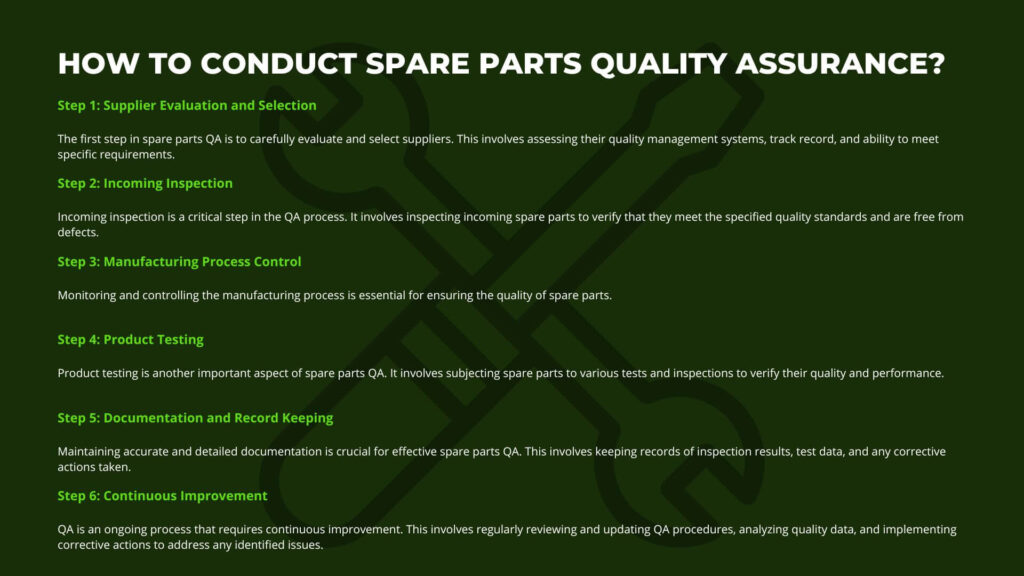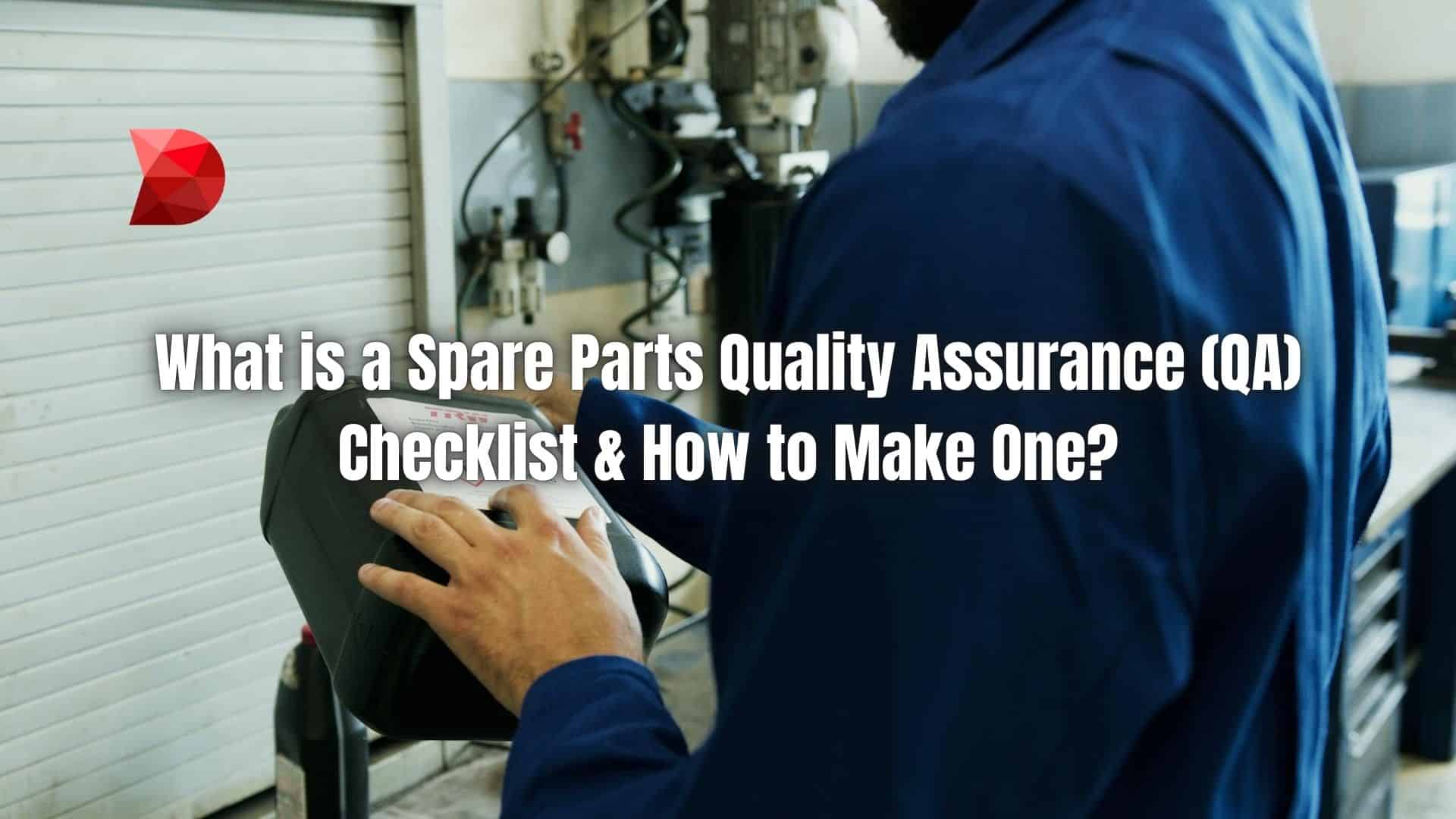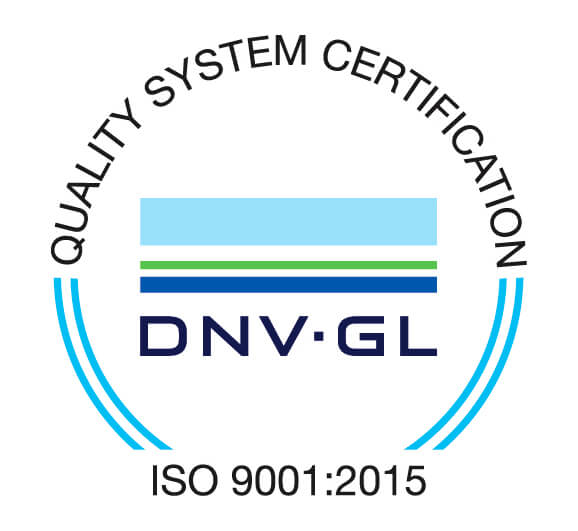Quality assurance in spare parts is vital for businesses that rely on these components for their operations. A well-crafted QA checklist can significantly enhance product quality, reduce costs, and improve customer satisfaction. This article will discuss the key elements of a spare parts QA checklist and provide practical guidance for its development and implementation.
Table of Contents
ToggleWhat is Spare Parts Quality Assurance?

Spare parts quality assurance (QA) is a critical process that ensures the quality of spare parts throughout their lifecycle. It involves inspecting, testing, and verifying spare parts at various stages of production and storage to identify and address any defects or non-conformities.
By implementing effective QA measures, businesses can improve product reliability, reduce downtime, and enhance customer satisfaction. This involves ensuring that spare parts meet the specified quality standards, are compatible with the main product, and comply with relevant safety regulations.
Understanding the Importance of Spare Parts QA
Spare parts QA is critical to any business that relies on components for its operations. It ensures that the spare parts used are of high quality, reliable, and compatible with the main product. This, in turn, leads to several benefits for the business.
Customer Satisfaction
Defective spare parts can lead to product failures, downtime, and frustrated customers. When customers encounter issues with their products due to faulty spare parts, it can damage their trust in the brand and lead to negative reviews and word-of-mouth. By prioritizing spare parts QA, businesses can minimize these problems and ensure that their customers have a positive experience.
Brand Reputation
A commitment to quality can enhance your brand’s image and foster trust. To draw in and keep consumers, a brand must have a solid reputation. When customers know that a brand is committed to quality, they are more likely to trust their products and services. By investing in spare parts QA, businesses can demonstrate their dedication to quality and build a positive brand image.
Cost Reduction
Preventing defects early in the process can save money on rework, returns, and warranty claims. Defective spare parts can lead to significant costs for businesses, including the cost of repairing or replacing faulty products, handling returns, and processing warranty claims. By implementing effective QA measures, businesses can identify and address potential issues before they become major problems, saving money and improving profitability.
Regulatory Compliance
Many industries have specific quality standards that must be met. In many industries, some specific regulations and standards govern the quality of spare parts. Failure to comply with these regulations can result in fines, penalties, and damage to a business’s reputation. By ensuring that their spare parts meet all relevant quality standards, businesses can avoid legal and financial risks.
Product Performance
High-quality spare parts contribute to the overall performance and longevity of a product. Using reliable spare parts can help to improve product performance, reduce downtime, and extend the product’s lifespan. This can lead to increased customer satisfaction and reduced maintenance costs.
How to Conduct Spare Parts Quality Assurance?
Conducting effective spare parts QA requires a systematic approach that involves several key steps. By following these steps, businesses can ensure that their spare parts meet the required quality standards and are suitable for their intended use:

Step 1: Supplier Evaluation and Selection
The first step in spare parts QA is to carefully evaluate and select suppliers. This involves assessing their quality management systems, track record, and ability to meet specific requirements. By working with reliable suppliers, businesses can reduce the risk of receiving defective or substandard parts.
Step 2: Incoming Inspection
Incoming inspection is a critical step in the QA process. It involves inspecting incoming spare parts to verify that they meet the specified quality standards and are free from defects. This could involve functional tests, dimensional checks, and visual inspections.
Step 3: Manufacturing Process Control
Monitoring and controlling the manufacturing process is essential for ensuring the quality of spare parts. This involves implementing quality control measures at various stages of production, such as inspecting raw materials, monitoring production processes, and conducting in-process inspections.
Step 4: Product Testing
Product testing is another important aspect of spare parts QA. It involves subjecting spare parts to various tests and inspections to verify their quality and performance. This may include functional tests, durability tests, and safety tests.
Step 5: Documentation and Record Keeping
Maintaining accurate and detailed documentation is crucial for effective spare parts QA. This involves keeping records of inspection results, test data, and any corrective actions taken. Proper documentation can help to identify trends, track quality performance, and demonstrate compliance with regulatory requirements.
Step 6: Continuous Improvement
QA is an ongoing process that requires continuous improvement. This involves regularly reviewing and updating QA procedures, analyzing quality data, and implementing corrective actions to address any identified issues. By continuously improving their QA processes, businesses can enhance product quality and reduce defects.
What is a Spare Parts Quality Assurance Checklist?
A spare parts quality assurance (QA) checklist is a structured document that outlines the specific steps, procedures, and standards that must be followed to ensure the quality of spare parts. It serves as a comprehensive guide for quality control personnel, providing a clear roadmap for inspecting, testing, and verifying the quality of spare parts throughout their lifecycle.
By using a QA checklist, businesses can streamline their quality control processes, enhance consistency, and reduce the risk of errors or defects. It helps to ensure that all necessary quality checks are performed, documentation is maintained, and corrective actions are implemented as needed.
Essential Elements of a Spare Parts QA Checklist
A well-designed spare parts QA checklist is a valuable tool for ensuring product quality and compliance. By incorporating the following essential elements, businesses can create a comprehensive checklist that effectively addresses critical areas of quality control.
Supplier Evaluation and Selection
- Assess supplier qualifications and certifications.
- Review supplier quality management systems.
- Evaluate supplier track record and performance.
- Conduct supplier audits or assessments.
Incoming Inspection
- Verify supplier documentation and certificates.
- Inspect incoming materials for defects, damage, and conformance to specifications.
- Perform necessary tests and measurements.
- Document inspection results and take corrective actions if necessary.
Manufacturing Process Control
- Define and document manufacturing processes and procedures.
- Implement quality control checks at critical stages of production.
- Monitor and control process parameters (e.g., temperature, pressure, humidity).
- Track and analyze process data to identify trends and areas for improvement.
Product Testing
- Develop a comprehensive product testing plan.
- Conduct functional, performance, and durability tests.
- Use appropriate testing methods and equipment.
- Compare test results to specifications and standards.
- Document test results and take corrective actions if necessary.
Dimensional Inspection
- Verify dimensions and tolerances using measuring instruments.
- Compare measurements to engineering drawings and specifications.
- Address any deviations or non-conformances.
- Document inspection results and take corrective actions if necessary.
Visual Inspection
- Inspect finished products for defects, damage, and appearance.
- Use checklists or standardized inspection forms.
- Pay attention to details such as scratches, blemishes, and misalignment.
- Document inspection results and take corrective actions if necessary.
Documentation and Record Keeping
- Maintain detailed records of inspection results, test data, and corrective actions.
- Use a standardized documentation system.
- Ensure that records are easily accessible and auditable.
- Regularly review and update documentation to reflect changes in processes or requirements.
Continuous Improvement
- Examine high-quality data to find patterns and areas that need work.
- Implement corrective actions to address identified issues.
- Continuously review and update the QA checklist to ensure its effectiveness.
- Encourage an organization-wide culture of quality and ongoing development.
Developing a Comprehensive Spare Parts Quality Assurance Checklist

A well-structured spare parts QA checklist is a crucial tool for ensuring product quality and reliability. To create a comprehensive checklist, follow these steps:
- Define Scope and Objectives: Clearly identify the specific spare parts that require QA, the scope of the checklist, and the desired outcomes.
- Conduct a Risk Assessment: Evaluate the potential risks associated with each spare part, considering factors such as criticality to product function, safety implications, and potential costs of failure.
- Identify Relevant Standards and Regulations: Determine the applicable industry standards, regulatory requirements, and customer specifications that the spare parts must meet.
- Gather Stakeholder Input: Involve relevant departments (e.g., engineering, manufacturing, quality control, procurement) to gather their insights and ensure the checklist addresses their specific needs.
- Outline Quality Attributes: Define the critical quality attributes for each spare part, such as dimensions, materials, performance characteristics, and appearance.
- Specify Inspection and Testing Requirements: Determine the appropriate inspection and testing methods, frequency, and acceptance criteria for each quality attribute.
- Establish Documentation and Record-Keeping Procedures: Define the necessary documentation to track inspection results, test data, and corrective actions.
- Implement Supplier Quality Assurance: Establish requirements for supplier evaluation, qualification, and ongoing monitoring to ensure that suppliers provide high-quality spare parts.
- Create a Clear and Concise Checklist: Develop a well-organized checklist that includes all the identified quality attributes, inspection and testing requirements, and documentation procedures.
- Regularly Review and Update: Periodically review the checklist to ensure it remains effective and aligns with changing requirements or industry standards.
Frequently Asked Questions (FAQs)
Q1: How often should a spare parts QA checklist be updated?
A spare parts QA checklist should be updated regularly to ensure it remains relevant and effective. The frequency of updates will depend on factors such as changes in product specifications, industry standards, regulatory requirements, or manufacturing processes. It’s generally recommended to review and update the checklist at least annually or more frequently if significant changes occur.
Q2: What is the difference between a quality control plan and a QA checklist?
While both quality control plans and QA checklists are important tools for ensuring product quality, they serve different purposes. A quality control plan outlines the overall strategy and procedures for achieving quality, while a QA checklist provides a detailed list of specific tasks, inspections, and tests to be performed. In essence, a QA checklist is a subset of a broader quality control plan.
Q3: How can I ensure that my spare parts QA checklist is effective?
To ensure the effectiveness of your spare parts QA checklist, it’s important to:
- Involve stakeholders: Get input from relevant departments (e.g., engineering, manufacturing, quality control) to ensure the checklist addresses their specific needs.
- Conduct regular reviews: Periodically review the checklist to identify areas for improvement and make necessary updates.
- Track and analyze data: Use data from inspections, tests, and corrective actions to identify trends and areas of concern.
- Provide training: Ensure that all relevant personnel are trained on the use of the checklist and understand their responsibilities.
Q4: Can a spare parts QA checklist be used for other types of products?
While a spare parts QA checklist is specifically designed for spare parts, many of the principles and practices can be adapted to other types of products. The key is to tailor the checklist to the unique characteristics and requirements of the product in question.
Q5: How can I balance the cost of QA with the potential benefits?
While QA can involve costs, the benefits often outweigh the expenses. By preventing defects early in the process, you can save money on rework, returns, and warranty claims. Additionally, investing in QA can help to improve product quality, enhance customer satisfaction, and protect your brand’s reputation.
Q6: What are some common mistakes to avoid when creating a spare parts QA checklist?
Some common mistakes to avoid when creating a QA checklist include:
- Overlooking critical areas: Ensure that the checklist covers all relevant aspects of spare parts quality, including supplier evaluation, incoming inspection, manufacturing processes, and product testing.
- Using vague or ambiguous language: Use clear and concise language to avoid confusion and ensure that the checklist is easy to understand and follow.
- Failing to update the checklist regularly: Keep the checklist up-to-date to reflect changes in product specifications, industry standards, or manufacturing processes.
- Ignoring data analysis: Use data from inspections, tests, and corrective actions to identify trends and areas for improvement.
Conclusion
In conclusion, a well-crafted spare parts QA checklist is a valuable tool for ensuring product quality, reducing costs, and improving customer satisfaction. By following the guidelines outlined in this article, you can create a comprehensive checklist that effectively addresses the specific needs of your organization.
The goal of this blog post was to provide a clear and actionable guide for developing and implementing a spare parts QA checklist. We have covered the key elements of such a checklist, the importance of QA, and practical tips for creating and using it effectively.
By following the steps outlined in this article, you can enhance your organization’s quality control processes, improve product reliability, and build a stronger reputation. We encourage you to start developing your spare parts QA checklist today and reap the benefits of improved product quality.
Streamline Spare Parts Quality Management with DATAMYTE
DATAMYTE is a quality management platform with low-code capabilities. Our Digital Clipboard, in particular, is a low-code workflow automation software that features a workflow, checklist, and smart form builder. This tool lets you create and implement Spare Parts Quality Assurance (QA) checklists, ensuring consistent inspections and quality control measures for every part and helping streamline spare parts quality management.
DATAMYTE also lets you conduct layered process audits (LPA), a high-frequency evaluation of critical process steps, focusing on areas with the highest failure risk or non-compliance. Conducting LPA with DATAMYTE lets you effectively identify and correct potential defects before they become major quality issues.
With DATAMYTE, you have an all-in-one solution for managing and optimizing every aspect of Spare Parts Quality Management, from initial inspection to ongoing compliance. Book a demo now to learn more.



